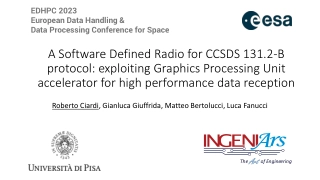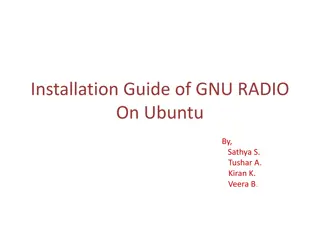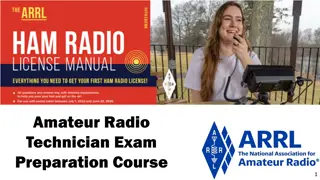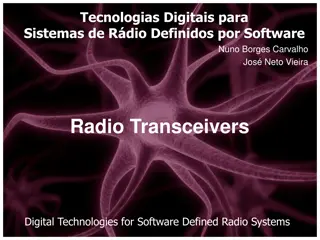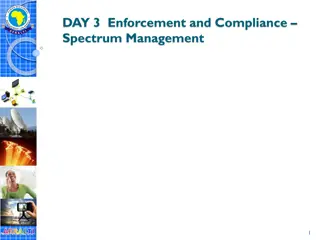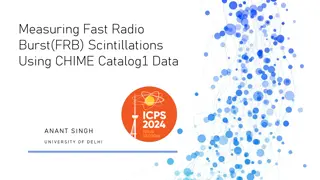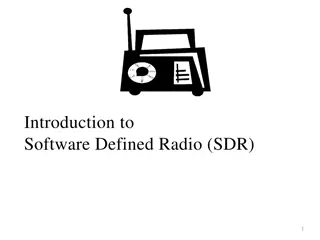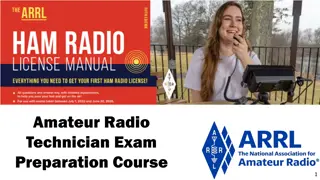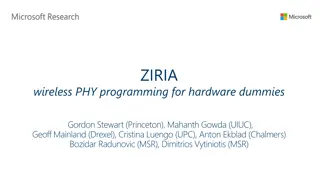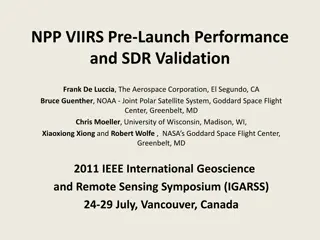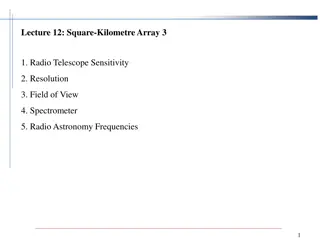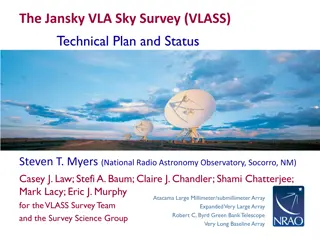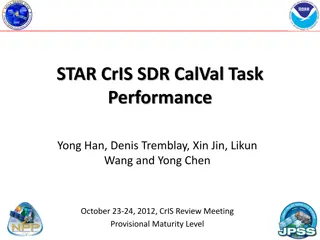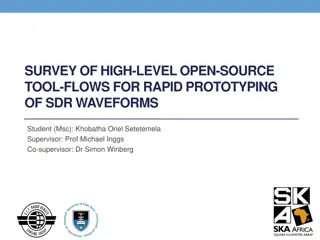Understanding Software-Defined Radio (SDR) with GNU Radio Introduction
Software-defined radio (SDR) revolutionizes radio technology by enabling flexible software-based solutions that can alter transmitter parameters without hardware changes. The SDR tiers defined by the SDR Forum provide evolving capabilities in terms of flexibility, transitioning from hardware-controlled to software-defined systems. GNU Radio introduction delves into the world of SDR, highlighting its implementation, benefits, and the shift towards more adaptable and efficient radio communication technologies.
Download Presentation

Please find below an Image/Link to download the presentation.
The content on the website is provided AS IS for your information and personal use only. It may not be sold, licensed, or shared on other websites without obtaining consent from the author. Download presentation by click this link. If you encounter any issues during the download, it is possible that the publisher has removed the file from their server.
E N D
Presentation Transcript
GNU RADIO INTRODUCTION BY SUMIT ABHICHANDANI VEERA BAPINEEDU NUNE TUSHAR AMBRE KIRAN KUMBHAR SATHYA SRIDHARAN UKASH
OUTLINE Introduction USRP USRP 2 USRP vs USRP2 References
INTRODUCTION SOFTWARE RADIO WHAT IS GNU RADIO
SOFTWARE RADIO An implementation technology A technique for moving digital signal processing as close as possible to the antenna Replacing rigid Hardware with flexible software based solutions A software (defined) radio is a radio that includes a transmitter in which the operating parameters of the transmitter, including the frequency range, modulation type or maximum radiated or conducted output power can be altered by making a change in software without making any hardware changes.
Defining software radio using tiers... The SDR Forum has defined the following tiers, describing evolving capabilities in terms of flexibility Tier 0 The Hardware Radio: Hardware components only cannot be modified ( Need physical intervention)
Defining software radio using tiers... The SDR Forum has defined the following tiers, describing evolving capabilities in terms of flexibility Tier 0:The Hardware Radio Tier 1 Software Controlled Radio (SCR): Only control functions software Extends to inter-connects, power levels etc. but not to frequency bands and/or modulation types
Defining software radio using tiers... The SDR Forum has defined the following tiers, describing evolving capabilities in terms of flexibility Tier 0: The Hardware Radio Tier 1: Software Controlled Radio (SCR) Tier 2 Software Defined Radio (SDR): provide software control of provide control of a variety of modulation techniques, such as Wide-band or narrow-band operation, Communications security functions (such as hopping), Waveform requirements of current and evolving standards over a broad frequency range. The frequency bands covered may still be constrained at the front-end requiring a switch in the antenna system
Defining software radio using tiers... The SDR Forum has defined the following tiers, describing evolving capabilities in terms of flexibility Tier 0: The Hardware Radio Tier 1: Software Controlled Radio (SCR) Tier 2: Software Defined Radio (SDR) Tier 3 Ideal Software Radio (ISR): Even the analog amplification or heterodyne mixing prior to digital- analog conversion is eliminated. Programmability extends to the entire system with analog conversion only at the antenna, speaker and microphones.
Defining software radio using tiers... The SDR Forum has defined the following tiers, describing evolving capabilities in terms of flexibility Tier 0: The Hardware Radio Tier 1: Software Controlled Radio (SCR) Tier 2: Software Defined Radio (SDR) Tier 3:Ideal Software Radio (ISR) Tier 4 (for comparison purpose only) Ultimate Software Radio (USR): Accepts fully programmable traffic supports a broad range of frequencies, air-interfaces & applications software. can switch from one air interface format to another in milliseconds, use GPS to track the users location, store money using smartcard technology, or provide video so that the user can watch a local broadcast station or receive a satellite transmission.
Defining software radio using tiers... The SDR Forum has defined the following tiers, describing evolving capabilities in terms of flexibility Tier 0: The Hardware Radio Tier 1: Software Controlled Radio (SCR) Tier 2: Software Defined Radio (SDR) Tier 3: Ideal Software Radio (ISR) Tier 4 : Ultimate Software Radio (USR) Cognitive radio (CR) : wireless communication in which a transceiver can intelligently detect which communication channels are in use and which are not, and instantly move into vacant channels while avoiding occupied ones.
BLOCK DIAGRAM TRANSMIT PATH RECEIVE RF FRONT END YOUR CODE HERE! ADC XMIT RF FRONT END YOUR CODE HERE! DAC
PLATFORMS WINDOWS Cygwin MinGW LINUX Ubuntu
SOFTWARE GNU Radio provides a library of signal processing blocks and the glue to tie it all together. LANGUAGES o C++ o PYTHON o SWIG
APPLICATION A TiVo equivalent for radio, capable of recording multiple stations simultaneously. Time Division Multiple Access (TDMA) waveforms. A passive radar system that takes advantage of broadcast TV for its signal source. For those of you with old TVs hooked to antennas, think about the flutter you see when airplanes fly over. Radio astronomy. TETRA transceiver. Digital Radio Mundial (DRM). Software GPS. Distributed sensor networks. Distributed measurement of spectrum utilization. Amateur radio transceivers. Ad hoc mesh networks. RFID detector/reader. Multiple input multiple output (MIMO) processing.
Overall Architecture Hardware
Basic USRP facts 4*ADC, 12 bit @ 64MSPS 4*DAC, 14 bit @ 128MSPS Altera EP1C12 FPGA for preprocessing tasks USB 2.0 interface to host PC (32 MB/s) Universal Software Radio Peripheral
Mother Board Four digital downconverters with programmable decimation rates Two digital upconverters with programmable interpolation rates Capable of processing signals up to 16 MHz wide Modular architecture supports wide variety of RF daughterboards Auxiliary analog and digital I/O support complex radio controls such as RSSI and AGC Fully coherent multi-channel systems (MIMO capable)
Transceiver port ADC Altera FPGA Power USB 2.0
ARCHITECTURE USRP (mother board) Sender User-defined Code RF DAC USB FPGA Front end PC One mother board support up to four daughter boards. Several kinds of daughter boards available modules that has been provided in GNU radio project to communicate between two end systems
Transmitter/Reciever 23 Sender User-defined Code RF DAC USB FPGA Front end PC USRP (mother board) Receiver User-defined Code RF USB FPGA ADC Front end
ARCHITECTURE USRP (mother board) Sender User-defined Code RF DAC USB FPGA Front end PC Support USB2.0/At this stage, USB 1.x is not supported at all 1. Support 32MB/sec across the USB. 2. Samples are in 16-bit signed integers in IQ format, 16-bit I and 16-bit Q data (complex), resulting in 8M complex samples/sec across the USB.
ARCHITECTURE USRP (mother board) Sender User-defined Code RF DAC USB FPGA Front end PC Includes digital down converters (DDC) implemented with cascaded integrator-comb (CIC) filters (for receivers). Digital up converters (DUCs) on the transmit side are actually contained in the AD9862 CODEC chips, not in the FPGA. The only transmit signal processing blocks in the FPGA are the interpolators.
FPGA Multiplexer MUX is like router Decides which ADC to each DDC
DDC Down converts the IF band into base band Decimates the signal to data rate so it can be transferred to usb.
ARCHITECTURE USRP (mother board) Sender User-defined Code RF DAC USB FPGA Front end PC 4 high-speed 14-bit DA converters, DAC clock frequency is 128 MS/s (stay below about 50MHz or so to make filtering easier.) 4 high-speed 12-bit AD converters, sampling rate is 64M samples per second.
Further developments in Gnu radio The current GNU Radio architecture primarily aimed at Streaming Radio The current scheduler relies on a steady stream of input data to processing blocks Packet Radio (TDD/TDMA) is therefore difficult to implement with precise timing Architectural change is implemented (USRP 2) Processing of arbitrarily sized blocks of data Treats input as messages, Data, Metadata Include modification to FPGA Python replaced by C++ as programming language
FEATURES 100 MS/s 14-bit dual (IQ) ADCs 400 MS/s 16-bit dual (IQ) DACs Gigabit Ethernet interface Allows for 25 MHz of RF BW each way @16bits Wide enough for WiFi! Bigger FPGA w/Multipliers (Spartan 3) 1 MB high-speed on-board SRAM High speed serial expansion interface
Features continued: Can operate without host computer External Frequency Reference Input Flexible choice of reference, not just 10 MHz Pulse per second (PPS) input for precise Timing Uses the same daughterboards as USRP1 - Only holds 1 TX and 1 RX - MIMO via expansion interface
USRP2 FPGA Spartan 3 - ~40K logic cells, Lots of RAM and multipliers 32-bit RISC Processor soft core - 50 MHz - GCC tool chain FIFOs and full crossbar between interfaces Precise timing control (10ns) for TDMA, etc.
FPGA can handle High sample rate processing, like digital up- and down conversion. Lower sample rate operations can be done in the FPGA, which contains a 32-bit RISC microprocessor. The larger FPGA allows the USRP2 to be used as a standalone system without a host computer in many cases
DAUGHTER BOARDS Provide transformation of mother board into a complete RF transreceiver system . Daughter boards provide various features which helps their integration into complex systems.
FEATURES: 30 MHz transmit and receive bandwidth Fully synchronous design, MIMO capable All functions controllable from software or FPGA Independent local oscillators (LOs) for TX and RX enable split-frequency operation &built-in T/R switching TX and RX on same connector or use auxiliary RX port 16 digital I/O lines to control external devices
VARIOUS DAUGHTER BOARDS USED RFX1800 Frequency Range: 1.5 to 2.1 GHz Transmit Power: 100mW (20dBm) RFX2400 Frequency Range: 2.3 to 2.9 GHz Transmit Power: 50mW (17dBm) XCVR2450 Frequency Range: 2.4 to 2.5 GHz, and 4.9 to 5.9 GHz Transmit Power: 100mW (20dBm) WBX0510 Frequency Range: 50 MHz to 1 GHz Transmit Power: 100mW (20dBm) RFX900 Frequency Range: 750 to 1050 MHz Transmit Power: 200mW (23dBm) RFX1200 Frequency Range: 1150 to 1450 MHz Transmit Power: 200mW (23dBm)
RFX900 Frequency Range: 750 to 1050 MHz Transmit Power: 200mW (23dBm) The RFX900 comes with a 902- 928 MHz ISM-band filter installed for filtering strong out-of- band signals (like pagers). The filter can easily be bypassed to allow usage over the full frequency range, enabling use with cellular, Paging and two-way radio, in addition to the ISM band.
New Transceiver Daughterboards (coming in '09) 50 MHz to 1 GHz Transceiver 800 MHz to 2.2 GHz Transceiver Both are MIMO Capable, 100+ mW output
Extensive use of Opencores.org Processor Wishbone Crossbar switch Wishbone Bus
USRP2 uses cross bar switches to perform MIMO via expansion interface
PROPERTIES/COMPONENTS REFERENCE CLOCK: External Input of 10 MHz (sine or square) can be provided. (DC blocked terminated at 50 ohms). Stability of the clock is 20ppm. Internal Input of 100 MHz (time stamped) is used by USRP2. PPS: Signals (0-5V) go directly to FPGA hence faster sync pulse is possible. PPS is for precise timing. (not DC blocked but AC terminated at 50 ohms and DC terminated at 1Kohms.
Properties/components Contd. RF Bandwidth: 25 MHz at 16 bits. Chipset: National Semiconductor PHY chip, DP83856. SD Card: Supposedly supports stand-alone mode as delay can be reduced in it. MIMO: USRP2 has MIMO cable port to exchange clock and data among USRP2 boards.
Properties/components Contd. AeMB processor: Heart of USRP2. It performs : Configuration of FPGA. Reports FPGA about all the peripherals. Controls Channel for daughterboard operation. It is clocked at 50 MHz.
Properties/components Contd. 1 MB SRAM: Used as: Large buffer to hold premodulated packets. Large FIFO to hold bursts of samples at higher rates than Ethernet. Auxiliary RAM for either Data or Instructions or both.
Properties/components Contd. High Speed Serial Link: Four differential signals in each direction: Carries data at 2 Gbps each way. Reference clock for phase locking oscillators. Time sync signal. One high speed differential link available for user. Network of USRP2 Line Cards : Two USRP2s linked directly. Four or more USRP2s linked by hub using MIMO.
APPLICATION FM RADIO RF ID READER CELLULAR GSM BASE STATION GPS RECIVER DIGITAL TV DECODER AMATUER RADIO
USRP v/S USRP 2 USRP USRP2 INTERFACE USB2.0 GIGABIT ETHERNET FPGA Xilinx Spartan 3 2000 ALTERA EP1C12 ADC SAMPLES 12- bit 64 MS/S 14- bit, 100 MS/S DAC SAMPLES 14 bit, 128 MS/s 16- bit, 400 MS/S DAUGHTER BOARD 2 TX, 2 RX 1 TX, 1 RX SRAM NONE 1 MEGABYTE
USB 2.0 and Ethernet USB 2.0 Ethernet Speed Mbps Gbps Driver Required Not Required Switch Not required Required (Gigabit Switch)


